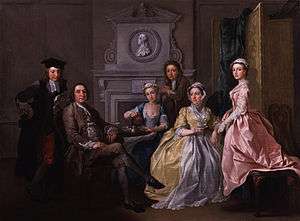Jonathan Tyers

Jonathan Tyers (10 April 1702 – 1767) was the proprietor of New Spring Gardens, later known as Vauxhall Gardens, a popular pleasure garden in Kennington, London. Opened in 1661, it was situated on the south bank of the River Thames on a site almost opposite the present-day Tate Britain.[1]
Life
Jonathan Tyers was born on 10 April 1702, probably in Bermondsey, Surrey, and was the son of Thomas Tyers, a wool-stapler, and his wife, Ann. Jonathan married Elizabeth Fermor (1700–1771) some time in the early 1720s, and together they had four children: Margaret (1724–1786), Thomas (1724/5–1787), Jonathan, and Elizabeth (1727–1802).[1] The couple may have separated in 1759 but this is unconfirmed.[1]
Prior to Tyers securing a thirty year[2] lease of New Spring Gardens from Elizabeth Masters in 1728, scant information is available about his early life,[3] except that he had worked in Bermondsey trading skins for the fellmongering company owned by his family.[4] According to the scholar John Lockman when Tyers leased the Gardens – for an annual payment of £250[3] – the venue was little more than a "much frequented rural brothel".[5] Under the management, and later ownership,[lower-alpha 1] of Tyers, the reputation of the Gardens evolved to one with a degree of respectability.[6]
The first major event Tyers organised at the Gardens was on 7 June 1732.[4] Styled as a Ridotto al Fresco – a ridotto in Italy was a fancy dress ball held outside[7] – 400 visitors paid the one guinea entrance charge.[4] Frederick, Prince of Wales, who owned the land the Gardens were on, was among the paying visitors.[4] The entertainment to be provided was advertised as scenes portraying pieces entitled 'The House of Ambition', 'The House of Avarice', 'The House of Bacchus', 'The House of Lust' and 'The Palace of Pleasure'.[4] It transpired the presentations did not take the form spectators expected as they conveyed a moralistic undertone; the next ridotto staged a fortnight later was a financial disaster with low attendance figures.[4] Shortly after the second ridotto, the artist William Hogarth, who had an apartment near to the Gardens at South Lambeth,[8] found his friend Tyers in a depressed state trying to decide whether it was better to commit suicide by drowning or hanging himself.[4] Hogarth's artworks were satires designed to communicate a moral lesson in a humorous manner[9] and he suggested Tyers should use similar methods to educate those seeking entertainment at the Gardens.[4] As an art collector with diverse interests Tyers already had a wide variety of friends in the artistic community and he commissioned several artists including Francis Hayman, – who Tyers later employed as his artistic director, a role he held for thirty years[4] – Hubert-François Gravelot, Louis-François Roubiliac as well as Hogarth to undertake the task of transforming the Gardens.[1] The venue and its entertainments were promoted as being family friendly yet to retain his profit margins Tyers ensured some areas remained unlit for the benefit of the sex workers.[10]
In 1734 Tyers purchased Denbies, a farmhouse and grounds near Dorking, Surrey, where he built himself a weekend retreat. The house Tyers built by converting some of the farm buildings appears to have been of little architectural significance as very little is known about it, but the Gothic garden he installed in the grounds became notorious. In contrast to the cheerfulness and merriment of Tyers' Vauxhall Gardens, The Valley of the Shadow of Death as it was known was designed to constantly remind visitors of their mortality.[1] David Coke and Alan Borg, authors of Vauxhall Gardens: A History (2012) have suggested that the contrast between the two gardens may have been symptomatic of "some sort of psychological imbalance"[10] within Tyers, perhaps even "a form of bipolar disorder".[10]
Death and legacy
Tyers died at his home in Vauxhall pleasure gardens on either 26 June or 1 July 1767.[1] Following Tyers' death the Denbies estate was sold,[11] and his sons Thomas and Jonathan became joint proprietors of the pleasure garden.[1]
References
Notes
Citations
- 1 2 3 4 5 6 7 8 Ranger, Paul (2005), "Tyers, Jonathan (1702–1767)", Oxford Dictionary of National Biography (online ed.), Oxford University Press, retrieved 15 April 2015 (subscription or UK public library membership required)
- ↑ McGairl, Pamela (November 1986), "The Vauxhall Jubilee, 1786", The Musical Times, Musical Times, 127 (1726): 611–615, JSTOR 964270
- 1 2 Fortescue (1993), p. 26
- 1 2 3 4 5 6 7 8 9 Coke, David (May 2012), "Vauxhall Gardens: Patriotism and Pleasure", History Today, 62 (5)
- ↑ Lockman (1841), p. 115
- ↑ Moore, Rowan (1 July 2011), "Vauxhall Gardens: A History by David E Coke and Alan Borg – review", The Guardian
- ↑ Coke (1984), p. 83
- ↑ Trusler (1833), p. 5
- ↑ Trusler (1833), p. 6
- 1 2 3 Barrell, John (25 January 2012), "The English pleasures of Vauxhall", Times Literary Supplement, The Times, archived from the original on 15 April 2015, retrieved 15 April 2015
- ↑ "England's Lost Country Houses — Denbies [I]", Lost Heritage, archived from the original on 15 April 2015, retrieved 15 April 2015
Bibliography
- Coke, David (1984), "Vauxhall Pleasure Gardens", in Snodin, Michael, Rococo: Art and Design in Hogarth's England, Trefoil Books, ISBN 978-0-86294-046-1
- Fortescue, Stephen E. D. (1993), The House on the Hill: the Story of Ranmore and Denbies, ISBN 095209150X
- Lockman, John (1841) [1751?], Forrester, Alfred Henry; Bunn, A., eds., The Vauxhall papers
- Trusler, John (1833), The Works of William Hogarth, Jones